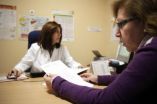(Press-News.org) When a person has a family history of cancer, their worry about developing the disease may lead to them refusing to have preventive tests. Advice from genetic counselling units reduces their anxiety but, until now, nobody knew how much. Now, a scientific team has validated the 'Escala de Preocupación por el Cáncer - EPC' (equivalent of the Cancer Worry Scale), the first of its kind in the Spanish language, in order to evaluate it.
"Excessive concern about cancer can result in two kinds of behaviour. Some people undergo excessive and unnecessary diagnostic tests, while others do not want to take any, out of fear that they will discover they have cancer", Esther Cabrera, lead author of the study and director of the School of Health Sciences at the Mataró-Maresme Technocampus (Barcelona), tells SINC.
Genetic counselling, in the case of patients with a family history of the disease, is the right kind of tool for reducing these worries. However, until now there has been no tool in the Spanish language for evaluating the effectiveness of this initiative, nor any instrument to evaluate the fear of suffering from cancer.
"I could say that genetic counselling works well, but I couldn't measure this", Ignacio Blanco, another author of the study and director of the Genetic Counselling Unit at the Catalan Institute of Oncology (ICO) in Barcelona, tells SINC. Now he has access to the 'Escala de Preocupación por el Cáncer' (EPC), an equivalent of the Cancer Worry Scale that shows him "that the degree of patients' concern does not increase following this counselling - quite the contrary", he adds.
The study, published in Medicina Clínica, shows that the EPC is a valid and reliable scale for evaluating concern about cancer in healthy people. It is a translation and a cultural adaptation of the English-language Cancer Worry Scale: six questions that measure concern on a scale ranging from 6 (the least) to 24 (the highest level).
From psychology to general medicine
The research study was carried out on 212 healthy women without any family history of breast cancer who attended the ICO Genetic Counselling Unit. Before the experts studied their family trees, the patients answered the test questions. Several days after the genetic counselling, the researchers once again distributed the scales to analyse the effectiveness of this tool.
One of the advantages of this tool is that it can be used in any of the branches of medicine that a patient seeks help from – psychology, oncology or even general medicine. "The scale can be used in primary healthcare as a filtering instrument among the healthy population to identify individuals with high levels of concern about cancer", the researchers say.
The simplicity of the questions (for example, "How worried are you about the possibility of developing cancer one day?") and the answers ("Not at all worried/A bit worried/ Quite worried/Very worried") make it possible to easily objectify "something that is difficult to measure", explains Esther Cabrera.
The tool has shown itself to be effective in alerting healthcare professionals to certain healthy patients who are unwilling to undergo preventive testing. "On many occasions, their fears are related to their decision about whether or not to take preventive measures that would help them avoid cancer or diagnose it a very early stage", Cabrera points out.
The researchers add that the tool will be useful for comparing and understanding the factors that affect the degree to which different groups of people worry. This would also make it possible to customise educational initiatives to improve people's quality of life.
INFORMATION:
Scale helps to measure the utility of genetic counseling in tackling fear of cancer
2011-06-09
ELSE PRESS RELEASES FROM THIS DATE:
German National Academy of Sciences Leopoldina submits statement on energy research
2011-06-09
The German National Academy of Sciences Leopoldina has submitted an ad-hoc statement on energy research to Prof. Annette Schavan, the German Federal Minister of Education and Research. Against the backdrop of the events in Fukushima, the statement contains twelve key declarations that mainly address research-policy issues connected to the restructuring of Germany's energy system.
The German National Academy of Sciences Leopoldina compiled the statement, entitled "Energiepolitische und forschungspolitische Empfehlungen nach den Ereignissen in Fukushima" (Energy- and research-policy ...
Treating children's eye infections without surgery
2011-06-09
PROVIDENCE, R.I. – Researchers from Hasbro Children's Hospital in Providence, R.I., report that medical management may be preferred over surgery for children with orbital cellulitis, an acute infection of the tissues surrounding the eye. They have determined the criteria for surgical intervention should be dependent upon the size of a subperiosteal abscess (SPA). The research is published in the journal Ophthalmic Plastic & Reconstructive Surgery and is now available online in advance of print.
Orbital cellulitis is most often the result of bacteria from a sinus infection, ...
Flooding of farmland does not increase levels of potentially harmful flame retardants in milk
2011-06-09
As millions of acres of farmland in the U.S. Midwest and South recover from Mississippi River flooding, scientists report that river flooding can increase levels of potentially harmful flame retardants in farm soils. But the higher levels apparently do not find their way into the milk produced by cows that graze on these lands, according to a study in the ACS journal Environmental Science & Technology.
Iain Lake and colleagues note that the flame retardants, called PBDEs, are found in a variety of household products including furniture upholstery, textiles, cars, plastics, ...
Poplar tree leaf bud extract could fight skin aging
2011-06-09
Antioxidants are popular anti-aging ingredients in skin creams, and now scientists are reporting a new source of these healthful substances — leaf buds of poplar trees. Their study appears in the ACS' Journal of Agricultural and Food Chemistry.
Xavier Vitrac and colleagues note that there's a long history of using poplar buds to treat various health problems, such as colds, sinusitis, sunburn and arthritis. A substance found in beehives that is made from poplar buds (called propolis) also appears to have similar disease-fighting benefits. Propolis' effects seem to be ...
Progress in tissue engineering to repair joint damage in osteoarthritis
2011-06-09
Medical scientists now have "clear" evidence that the damaged cartilage tissue in osteoarthritis and other painful joint disorders can be encouraged to regrow and regenerate, and are developing tissue engineering technology that could help millions of patients with those disorders. That's the conclusion of a new analysis of almost 100 scientific studies on the topic, published in ACS's journal Molecular Pharmaceutics.
Tong Cao, Wei Seong Toh and colleagues point out that damage to so-called articular cartilage — the smooth, white, rubbery tissue that covers and cushions ...
What to do with bisphenol A: Ban it, restrict it, leave it alone?
2011-06-09
Despite years of scientific studies, reports, lawsuits, congressional inquiries, claims and counterclaims, the question of whether bisphenol A (BPA) poses health threats to people lacks a definitive answer, according to a package of articles on the controversial substance in the current edition of Chemical & Engineering News (C&EN), ACS's weekly newsmagazine.
In the articles, C&EN Senior Correspondent Stephen K. Ritter explains that BPA has been used in an array of consumer goods since the 1950s. Today it is a mainstay ingredient in hard plastics in some reusable drink ...
Ordered fear plays a strong role in market chaos
2011-06-09
COLLEGE PARK, MD (June 8, 2011) -- When the current financial crisis hit, the failure of traditional economic doctrines to provide any sort of early warning shocked not only financial experts worldwide, but also governments and the general public, and we all began to question the effectiveness and validity of those doctrines.
A research team based in Israel decided to investigate what went awry, searching for order in an apparently random system. They report their findings in the American Institute of Physics' journal AIP Advances.
The novelty of their study is the ...
Shop. Prep. Cook. Taste.
2011-06-09
Dick Patrick Studios releases new "Shop, Prep, Cook, Taste" Promo Book.
Dick Patrick Studios has teamed up with designer Garrett Owen to create a new promo piece entitled "Shop, Prep, Cook, Taste." The goal of the brochure is to showcase Patrick's holistic approach to shooting food photography by breaking down the food industry into its four component parts and illustrating them with photography.
Each dish in the piece has a unique story all its own, and Patrick uses his skills with the camera to bring every step in the food preparation process ...
An alternative to antibiotics
2011-06-09
More and more pathogens are becoming immune to antibiotics. Some bacteria can no longer be combated. The World Health Organization WHO is warning about resistance to drugs which were once so potent. The WHO's director-general Margaret Chan has pointed out that if measures are not taken quickly, it may soon not be possible to treat many frequently occurring infections. Figures released by the WHO show that in 2010 nearly half-a-million people were infected with a strain of tuberculosis which is resistant to many antibiotics – one third of those infected died. The Organization ...
The future of stem cell applications challenging, bright
2011-06-09
An article in the current issue of Technology & Innovation, Proceedings of the National Academy of Inventors ™ reports on the bright future and enormous need for stem cell therapeutics that may offer hope for those suffering from debilitating and deadly diseases.
www.cognizantcommunication.com
Stem cell transplantation may offer therapy through "simple cell replacement" procedures to restructure damaged organs, tissues and cells, or provide methods for "reawakening" biological cues to regenerate cells.
"The future for stem cell applications is indeed promising, ...



